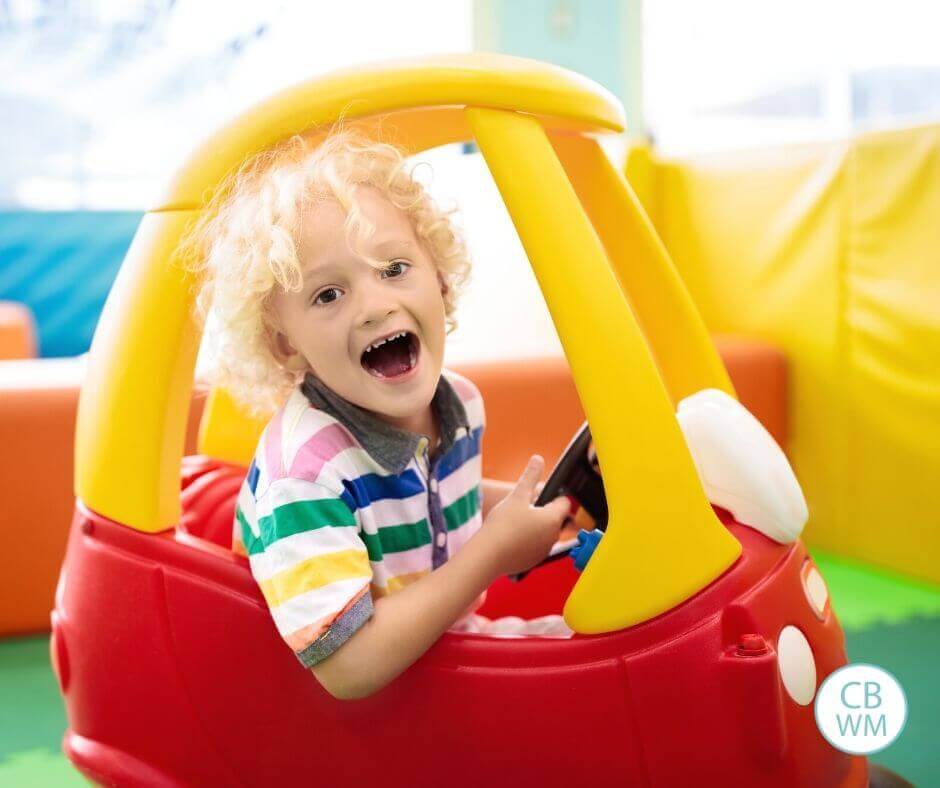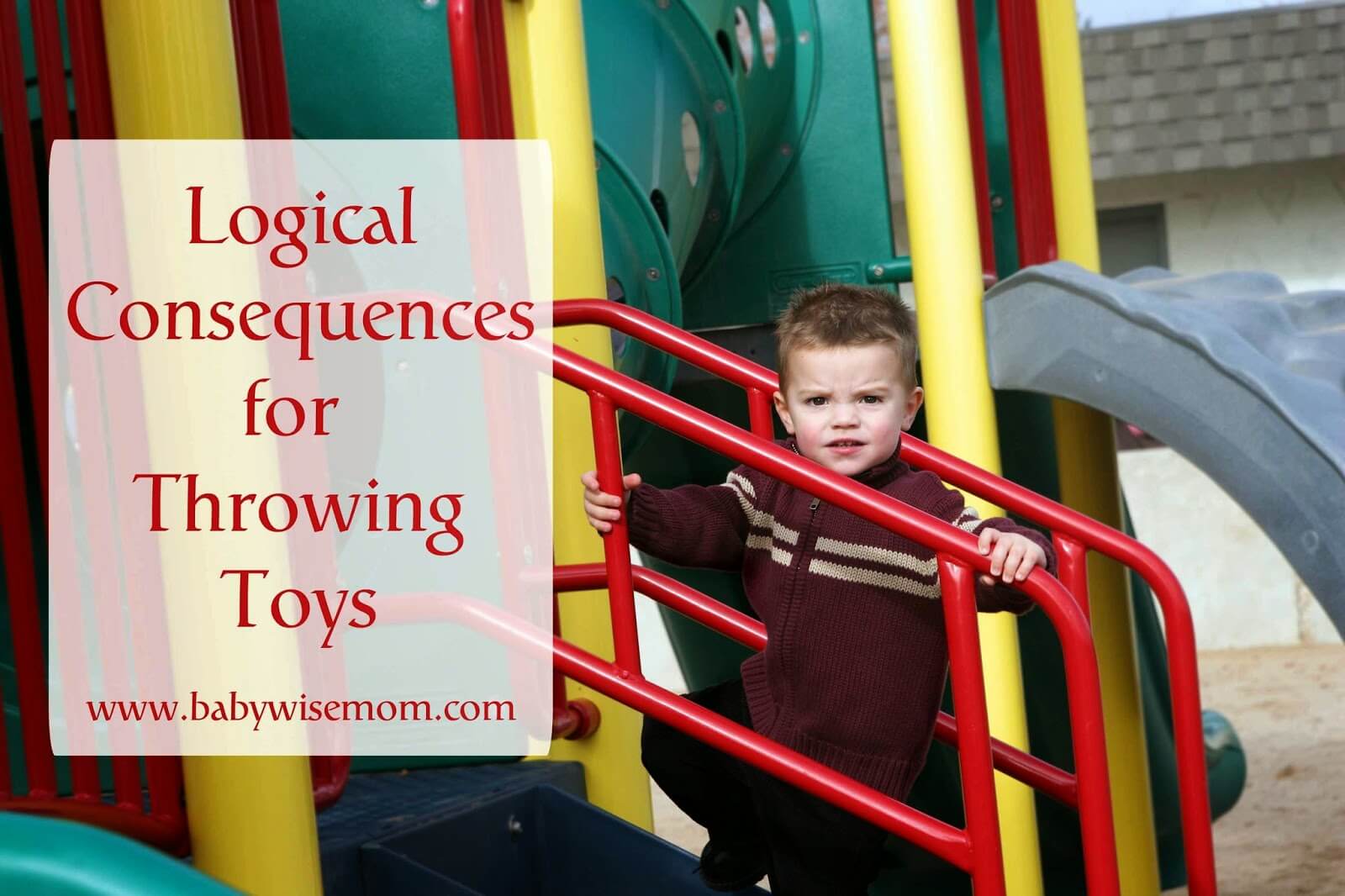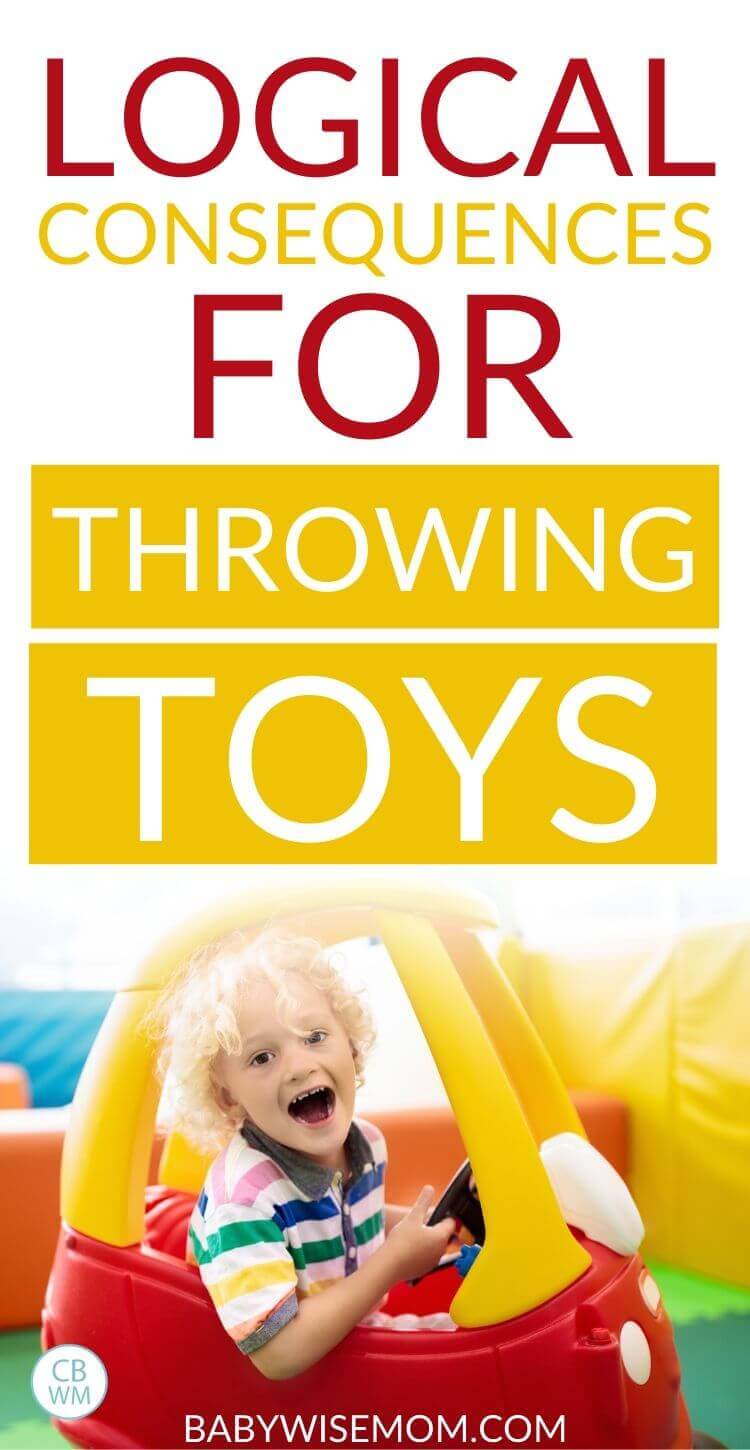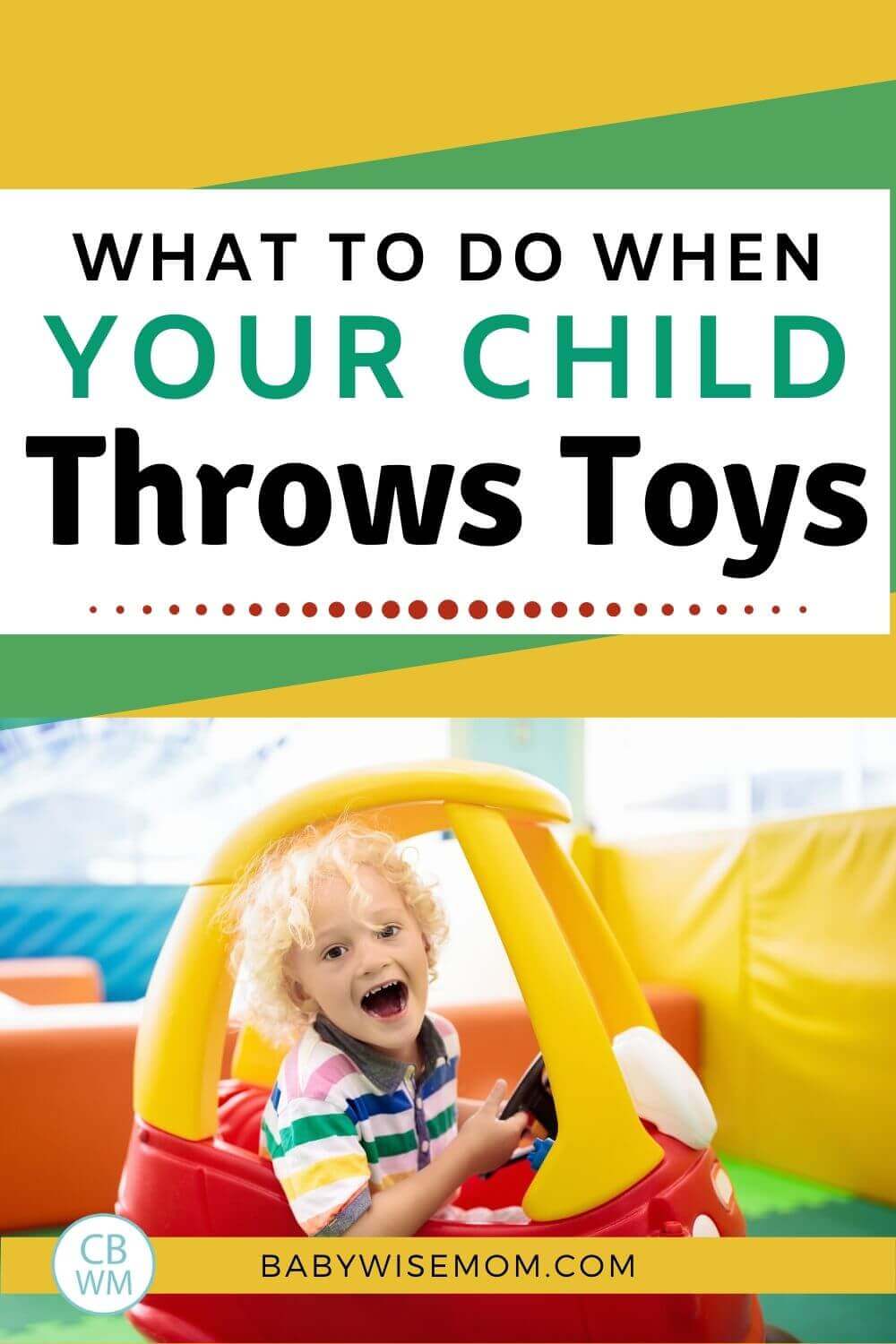A breakdown of how to respond when your child throws toys. Get age-appropriate consequences for throwing toys.

Logical and natural consequences are my favorite ways of correcting my children. They provide discipline that teaches a lesson and leads to changing behavior in the future. That is exactly my goal in correcting my kiddos, so consequences are my go-to.
Post Contents
Logical Consequences for When Kids Throw Toys
If your little one is throwing toys, you are probably wondering how to best handle the situation. One mom asked me for help with logical consequences for throwing toys:
Throwing toys – my 15 month old angel is getting such a kick out of tossing them everywhere despite my redirection!
This is very simple for me and is the same response no matter what the age.
The child throws a toy, the child doesn’t get to play with that toy.
Simple as that.
Caveats
Now, let’s talk some caveats here.
There seem to always be caveats.
First, throwing purposefully and dropping accidentally are not the same thing. I don’t discipline for accidents (though we do require apologies for accidents).
We also must address the fact that young children (baby and early pre-toddler) need to drop things over and over to learn cause and effect. It is part of growing up, so I am not saying that throwing and dropping toys isn’t appropriate ever.
That doesn’t mean you can’t set boundaries. There will be times, places, and toys that are appropriate for throwing and dropping, and there will be times, places, and toys that aren’t appropriate for throwing and dropping.
When your little one is at that age when the dropping and throwing is part of development, give your toddler time to practice the skill. You can still have times and places this isn’t okay even when your child is learning all about it. Provide some time in the day for your child to practice dropping things over and over.
For McKenna, that ended up being at church. She dropped her toys at church over and over again. This was fine because it wasn’t disrupting anything. It worked out well because she got her obsessive time in. She also associated the game with church, so she didn’t really do it at home.

How to Apply the Consequence
Once again, if the child throws a toy inappropriately, then the child loses the toy to play with.
The child’s age will impact the severity of not getting to play with that toy. Let’s go over some ages.
Baby. 6-12ish Months Old
Most babies aren’t going to be able to start dropping things on purpose until 6 or 7 months old. Some might around 5 months old. A baby is not going to be able to actually throw a toy until closer to 12 months, which is why I use the term “drop.”
If and when baby drops a toy, and if it is a situation I don’t want toys to be dropped repeatedly, I would start by telling the child something to the effect of, “Don’t drop your toy. If you drop your toy, you won’t get to play with it.”
Another option would be, “Don’t drop your toy. If you drop your toy, you will have to sit on the floor to play with it.”
Then, you follow through.
Always follow through.
Either don’t pick the toy back up, or sit the child on the floor to play with the toy.
Remember, dropping toys is something to allow when it is appropriate. Only apply the consequence when it is not appropriate.
>>>Read: Discipline Foundations for Your Baby
Pre-Toddler. 12-15 Months Old
This section might apply to children around 10 months old or so, also. See what you think is best for your child.
By this age, your child understands what you mean by no. Most children will also be capable of actually throwing toys at this age. Most will also start mini-fits in this age range.
So let’s say the child throws the toy in order to have fun. I would say, “That’s a no. You don’t throw your toys in the house. You can throw balls outside, but no throwing toys in the house. If you throw your toy again, you will lose it.”
Then if and when baby threw that toy, I would take it away. At this age range, I would only take it away for that wake cycle or possibly as long as that whole day.
If baby threw the toy out of complete anger, I would take the toy away immediately. I would say, “Whoa. That is not okay. We do not throw our toys like that. You may not play with this toy since you threw it.”
Remember, if you have a child obsessed with throwing, create times and places that it is okay to throw. Perhaps outside is a good spot to throw.
If outside is not an option, perhaps one room in the house can be the room where throwing can happen. You can get a soft ball and keep the throwing in a certain room. Your pre-toddler is smart enough to get it.
Just keep in mind that the rules you set now will carry on to older ages. When Brayden was around this age, I allowed him to throw balls in the house because he couldn’t throw them far or hard.
But of course, he grew. As he grew, so did his throwing ability. Suddenly, throwing balls in the house wasn’t always a great idea.
I never allowed Kaitlyn to throw balls in the house because I had learned my lesson. As they grew and Brayden was 5 and Kaitlyn 3, Brayden still had a harder time remembering to not throw balls in the house than Kaitlyn.

Pre-Toddler. 15-18 Months Old
I suppose much of the same would apply to this age group as the previous. During this age range, I would take the toy away for longer periods of time than previously.
I would take away the toy for at least a day, maybe even up to a few days depending on the child.
Toddler. 18-24 Months Old.
Let’s continue to build on this. As the child enters this toddler age range, I would have higher expectations for remembering rules and would not feel inclined to give warnings.
If throwing toys was a repeated problem, I would stop warnings and just take the toy away the first time it was misused.
Toddler. 2-3 Years Old.
Once I was sure the child understood the rule for no throwing toys in the house, I would stop warnings during this age range.
I would have a minimum of time for toy loss at 3 days, possibly up to a week. You don’t want it to be too long because the child will likely forget about the toy.
3-7 days might seem super long to you, but while you don’t want it too long, you also want it long enough that the child will truly work to not throw toys in the future.
If the child repeatedly threw a certain toy, I would warn that if he didn’t stop, he would lose the toy until he was older and able to be responsible with the toy. I would then take it away for 2-4 weeks.
Preschooler and Older.
As the child gets older, you can expect higher rates of obedience. You also can expect the ability for remembering rules.
If toy throwing is a problem, you might completely take away the toy and donate it somewhere.
I would give a warning before doing this. “Now son, if you can’t stop throwing this toy, then you are going to have to get rid of it. You will not be able to play with it anymore. Do you understand?”
Wait for the response.
“Do you want to lose this toy forever?”
Wait for a response.
“Then what do you need to do?”
Wait for a response.
“That is right. You need to not throw this toy.”
Prevention
Remember that prevention is key. To prevent toy throwing, be sure to keep toys interesting. Often times a child will throw toys when he/she is bored and trying to find ways to make playtime more interesting.
Also be sure you allow time and opportunity for the child to practice dropping and throwing skills as age-appropriate. You also need to be aware of overtiredness and hunger. Apply mercy in these situations.
>>>Read: Discipline Strategy: Think Prevention First

Conclusion
It can seem harsh to expect obedience and have consequences for things with kiddos this young, but it really pays off in the long run. When your pretoddler, toddler, and preschooler get used to listening to you, they carry that through into the child years and even the teen years.
When your little one learns that actions have consequences, they learn to be more considerate of others and more respectful of rules as kids.
These years are vital for helping make parenting easier than it would otherwise be in later years.
RELATED POSTS
- Consequences: Natural VS Logical and How to Use Each
- How To Respond When Your Child has a Public Tantrum
- How to Keep Your Kiddo Still for Diaper Changes
- 10 Guidelines for Using Logical Consequences
This post originally appeared on this blog June 2010
